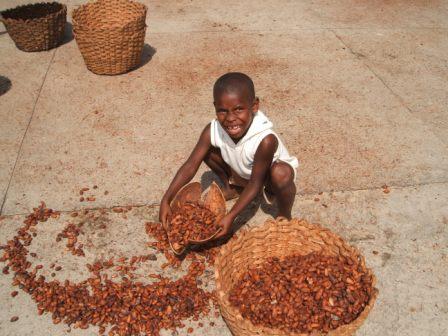This article originally appeared on Policymic.
It’s rather difficult to think about Valentine’s Day without the holiday’s two major selling products: flowers and chocolate. In a recently released survey about Valentine’s Day spending, the National Retail Federation reported that 47.5% of adults buy candy for Valentine’s Day, and 34.3% buy flowers. It is the biggest day of the year for some florists and chocolate makers. But when making such purchasing decisions, few shoppers know about the controversial background of these two products: the exploitation of adults and children. As we make our Valentine’s Day purchases this year in the hopes that our gifts will make loved ones happy, we must also consider the human consequences of our spending decisions.
The majority of flowers purchased in the U.S. come from Colombia and Ecuador, where flower workers routinely face labor violations. In a push to meet the demands of Valentine’s Day, workers have been reported to log up to 20 hours a day, at 250-300 stems per hour. According to the Victoria International Development Education Association, two-thirds of Colombian and Ecuadorian flower workers suffer from work-related health problems, including headaches, nausea, impaired vision, conjunctivitis, rashes, asthma, stillbirths, miscarriages, congenital malformations, and respiratory and neurological problems. These problems, especially those associated with birth defects, are primarily attributed to the chemicals that workers are exposed to while on the job. Approximately 20% of pesticides used in Colombian flower production are known carcinogens or toxins that have been either restricted or prohibited in North America and Europe.
Thousands of miles away in West Africa, similar abuses are occurring on cocoa plantations, where 70% of cocoa, the main ingredient in Valentine’s Day chocolate, is grown. However, in addition to all of the health risks associated with growing and harvesting cocoa, these problems are concentrated among thousands of children who work in cocoa fields every day.
Children as young as 5 and 6 years old are required to perform dangerous tasks on cocoa fields, such as chopping down cocoa pods with machetes, breaking the pods open with knives, carrying heavy loads of cocoa beans, and spraying dangerous chemicals such as pesticides, herbicides, and insecticides. These hazardous activities have resulted in injuries and an inability to attend school.
So how do Valentine’s Day consumers make a difference this year? One option is to opt for products that have been certified to promote worker rights and protections.
When purchasing flowers, look to One World Flowers, 1800Flowers, and Sam’s Club, which offer Fair Trade certified bouquets. Likewise, Organic Bouquet tulips and Whole Foods flowers are certified through the VeriFlora program, which sets standards for worker rights, water conservation, recycling, and organic production.
Buying chocolate that is guaranteed to have been made without child labor is more complicated. All of the major chocolate brands (Hershey, Mars, Kraft, Nestle, and others) committed in 2001 to certify all of their products by 2005, but seven years have passed since that deadline and the progress has been slow. Some companies have made lofty and important goals: Mars, for example, has committed to certifying 100% of its cocoa supply chain by 2020. In November of last year Nestle partnered with Fair Labor Association to audit its entire supply chain. And more recently, on January 30of this year Hershey announced that it would supply 100% of the chocolate made in its Bliss and Dagoba brands (which represent a very small share of Hershey’s market) from Rainforest Alliance certified chocolate.
Many other smaller brands have already sourced certified cocoa through Fair Trade, Rainforest Alliance, and UTZ certified farms and cooperatives. Look for Guittard, Equal Exchange, Green and Blacks, Sweet Earth Chocolates, Theo Chocolate, Divine, and Alter Eco, for certified chocolate. In addition, Trader Joe’s, Whole Foods, and Ikea manufacture their own lines of certified chocolate.
The rise in ethical consumerism over the past two decades is evidence that spending money where our values are is an effective way of pressuring corporations to become more ethical. As supply chains become longer and more complicated, it is increasingly important for consumers to understand where their products come from, and under what conditions they were produced.
Established in 1995, the Georgetown Public Policy Review is the McCourt School of Public Policy’s nonpartisan, graduate student-run publication. Our mission is to provide an outlet for innovative new thinkers and established policymakers to offer perspectives on the politics and policies that shape our nation and our world.
